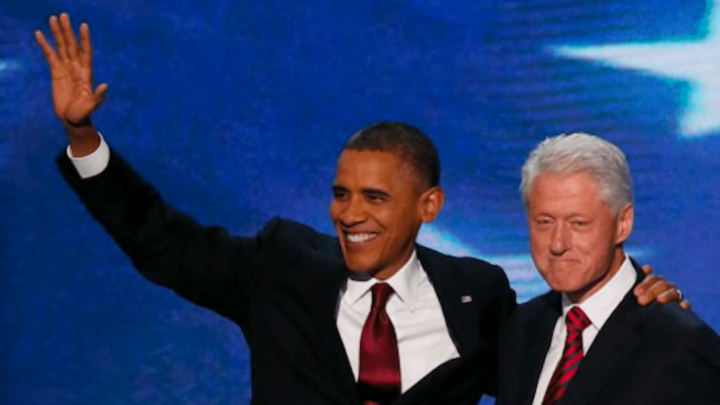By the time Hillary Clinton emerged as the presumptive Democratic presidential nominee, the former Secretary of State had won a majority of pledged delegates, the states that had held primaries, and the popular vote. Adding to that lead: an outsized chunk of superdelegates she had managed to bring over to her side.
Superdelegates are the wild card in the Democratic party’s nominating contest: Unlike regular delegates, the superdelegates, totaling about 712, are “unbound,” meaning they aren’t required to vote for the candidate who won their state and can switch allegiances right up to the convention. It’s an extremely powerful position. But how does one actually land the gig?
According to the Democratic Call for the 2016 Convention, the spots are reserved for Democratic power players. That includes:
- The Democratic president, Democratic vice president, and all former Democratic presidents and vice presidents (so, yes, President Obama and Bill Clinton are superdelegates who have—spoiler alert!—said they’ll vote for Hillary Clinton).
- All current Democratic U.S. senators and representatives (that includes Bernie Sanders, who, despite being an independent, won the designation when he decided to run for the Democratic nomination; but not Clinton herself, who is no longer a senator).
- Current Democratic governors (including territories such as American Samoa, and the mayor of Washington, D.C.).
- All former majority and minority leaders of the U.S. Senate.
- All former Speakers and minority leaders of the House of Representatives.
- Democratic National Committee officials, such as the chair and vice chair of each state’s Democratic party, along with members elected to represent each state at the convention (but if one person fulfills multiple roles, they still only get one vote. For instance, Debbie Wasserman Schultz is both Chair of the DNC and a representative from Florida, but she only gets one vote).
- All former DNC chairs.
So, what about the Republicans? Superdelegates are primarily an invention of the Democratic party. The GOP’s version, which only constitutes about 7 percent of the total delegates on the Republican side, is comprised of three members from each state’s national party committee. And, unlike Democratic superdelegates, they’re required to vote for whoever won their state’s primary or caucus—giving them far less power than their peers on the other side of the aisle.
Overall, the system is a relatively recent construct. After the 1968 election, when Hubert Humphrey won the nomination without winning a single primary, the Democratic party sought to change its nomination process so it could be more inclusive. George McGovern, a senator from South Dakota, chaired the commission, which replaced the status quo—nomination by party bosses—in favor of more democratic processes, allowing more proportional representation in pledged delegates.
Democrats used that system in 1972 and (with some minor tweaks) in 1976 without much general election success. To their chagrin, party elites soon realized that they’d been effectively cut off from helping select the nominee. In turn, the party ended up with nominees who weren’t as strong against Republican rivals: McGovern, who lost to Richard Nixon in 1972, and Jimmy Carter, who failed to win re-election.
Party leaders saw the need for a system to check the will of the people, or what Politico has called “an ‘emergency brake,’ a last chance to avoid disaster.” They also saw a need for a unifying force within the party after Democratic Senator Ted Kennedy challenged incumbent President Carter for the nomination in 1980. That gambit left the party in chaos, divided amongst itself. In response, the Hunt Commission was tasked with reforming the process yet again. That’s when they landed on the idea of superdelegates.
Geraldine Ferraro, the Democratic candidate for vice president in 1984 and member of that commission, wrote about the party’s goals with the superdelegate system in The New York Times in 2008:
“Democrats had to figure out a way to unify our party. What better way, we reasoned, than to get elected officials involved in writing the platform, sitting on the credentials committee, and helping to write the rules that the party would play by?”
Since the system’s inception in the 1980s, left-wing members of the party have argued that having superdelegates is undemocratic because this system gives party elites disproportionate influence over the nomination process. That argument picked up steam in the 2016 election when Bernie Sanders lambasted superdelegates voting for Clinton, tried to bring them over to his side, and eventually called for their demise.
But although they constitute about 15 percent of the 4763 Democratic delegates, no candidate who has lost the popular vote has won the nomination thanks to an abundance of superdelegate votes. The closest they came to deciding a nomination was in the 1980s. While political scientists still debate whether former Vice President Walter Mondale’s victory in 1984 was down to superdelegates, or if he secured the win thanks to other means with the superdelegates as cushioning, it was the closest superdelegates have ever come to deciding a race.
So, while Sanders has declared that his strategy to win the nomination will be to convince Clinton’s superdelegates to come over to his side before the convention, in the end, it may not matter.
